
Ceramium is a genus of Ceramium algae. It is a large genus with at least 15 species in the British Isles.

Polysiphonia is a genus of filamentous red algae with about 19 species on the coasts of the British Isles and about 200 species worldwide, including Crete in Greece, Antarctica and Greenland. Its members are known by a number of common names. It is in the order Ceramiales and family Rhodomelaceae.

Polysiphonia lanosa is a common species of the red algae (Rhodophyta) often to be found growing on Ascophyllum nodosum.
Polysiphonia atlantica is a small filamentous species of red marine algae Rhodophyta. The thalli form small tufts up to 3 cm long. The axes are ecorticate consisting of axial cells surrounded by four periaxial cells.
Polysiphonia brodiei (Dillwyn) Sprengel, now generally spelled "brodiaei", as it is named after James Brodie is a species of red algae in the Rhodophyta. It grows in tufts up to 36 cm long.

Polysiphonia ceramiaeformis, also called banded siphon weed, is a small red algae (Rhodophyta), in the genus Polysiphonia. Individuals are irregularly branched with the branches extending up to 5.5 centimetres (2.2 in) from a central node and ending in dense tufts of fibres.
Polysiphonia denudata is a small red alga, Rhodophyta, growing as tufts up to 20 cm long without a main branch axis.
Polysiphonia devoniensis is a species of marine algae. It is a small red alga in the Division Rhodophyta. It is a species new to science only described recently and first published in 1993.
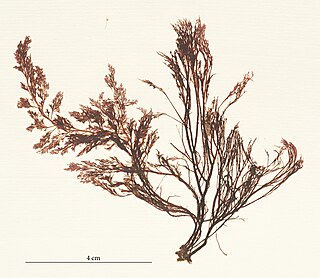
Polysiphonia elongata is a small red marine algae in the Rhodophyta.
Polysiphonia fibrata is a species of Polysiphonia that grows as small dense tufted and finely branched marine alga in the Rhodophyta.
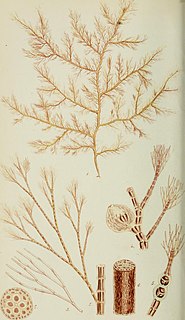
Polysiphonia fibrillosa (Dillwyn) Sprengel is a species of marine red alga in the Rhodophyta.
Polysiphonia furcellata (C.Agardh) Harvey is small marine red alga in the Division Rhodophyta.

Melanothamnus harveyi, Harvey's siphon weed, is a small marine red alga in the division of Rhodophyta.

Choreocolax polysiphoniae is a minute marine parasitic alga in the division Rhodophyta.
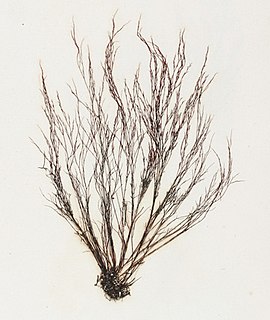
Polysiphonia nigra is species of marine alga in the division Rhodophyta.
Polysiphonia opaca (C.Agardh) Moris et De Notaris is a small marine alga in the division Rhodophyta.

Polysiphonia simulans is a small marine alga in the division Rhodophyta.
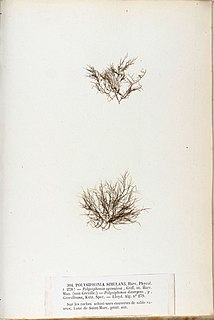
Vertebrata simulans Harvey is a small densely branched alga in the Division Rhodophyta.
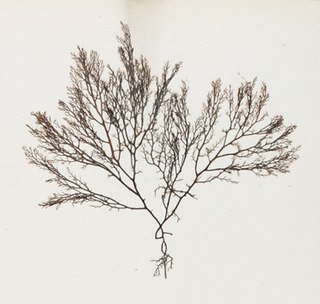
Vertebrata fruticulosa(Boergeseniella fruticulosa Kylin) is a small marine alga in the Division Rhodophyta.

Ceramium echionotum is a small marine alga in the division Rhodophyta.













